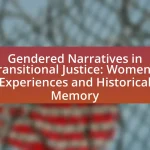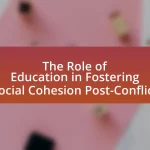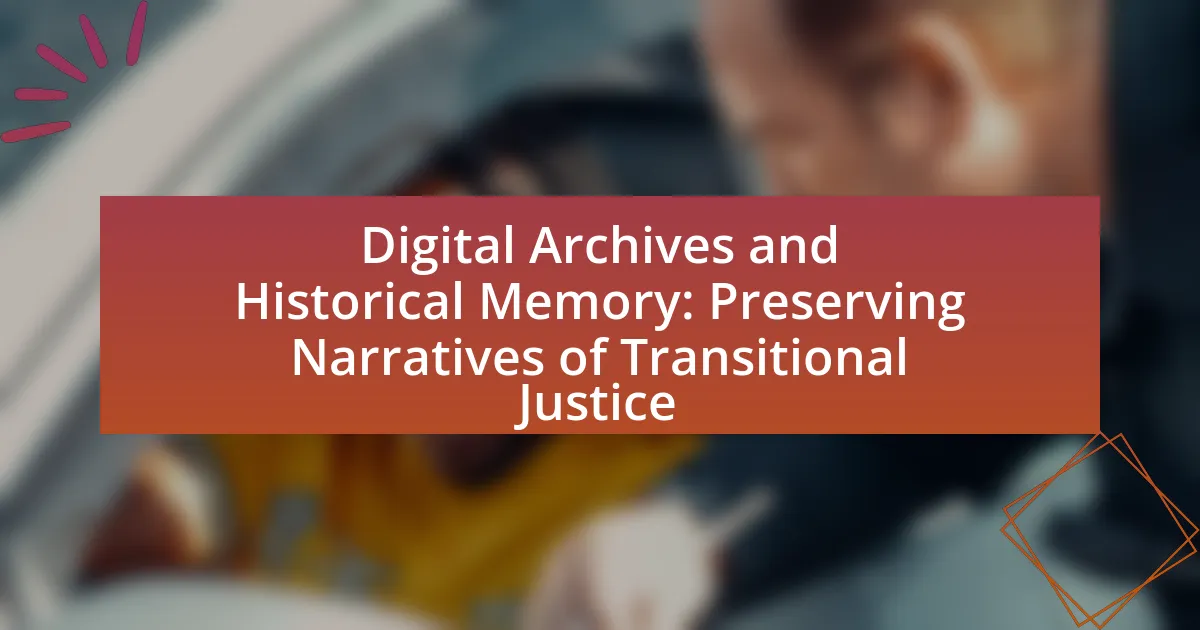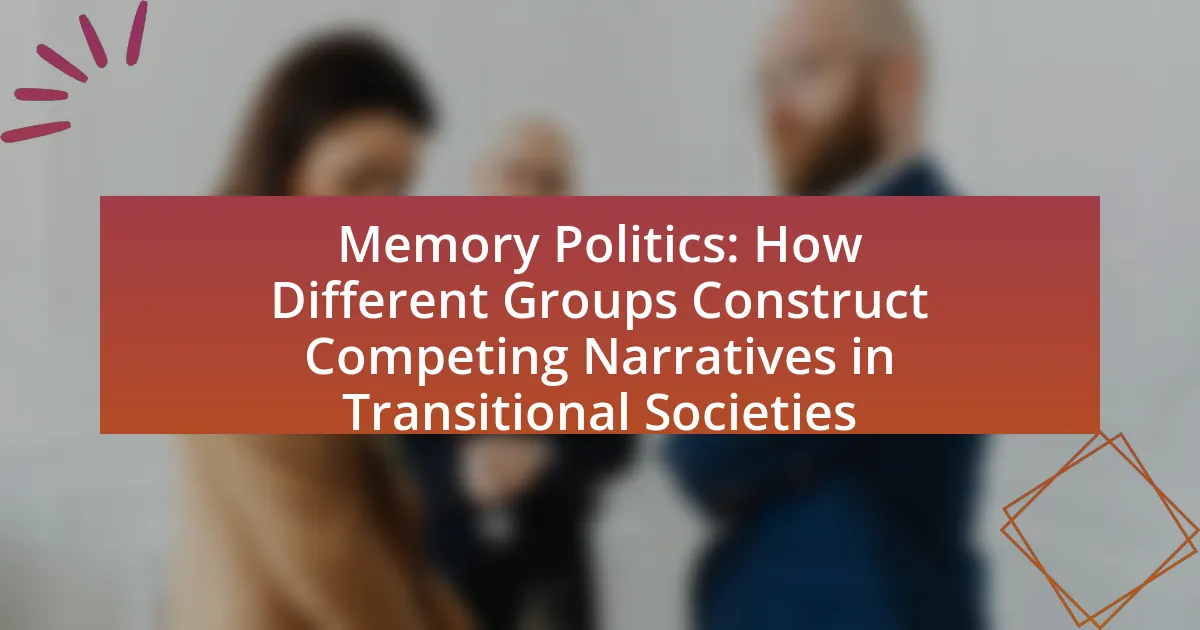The article examines the impact of historical narratives on post-conflict reconciliation, emphasizing their role in shaping collective memory and identity. It discusses how these narratives can either promote understanding and empathy or perpetuate division and resentment, using case studies from Rwanda and the Balkans to illustrate these dynamics. Key components of effective historical narratives for reconciliation are identified, including truth-telling and inclusive perspectives, while the article also explores the psychological effects of these narratives on individuals and communities. Additionally, it highlights the importance of education and media in shaping historical narratives and their implications for peacebuilding initiatives.
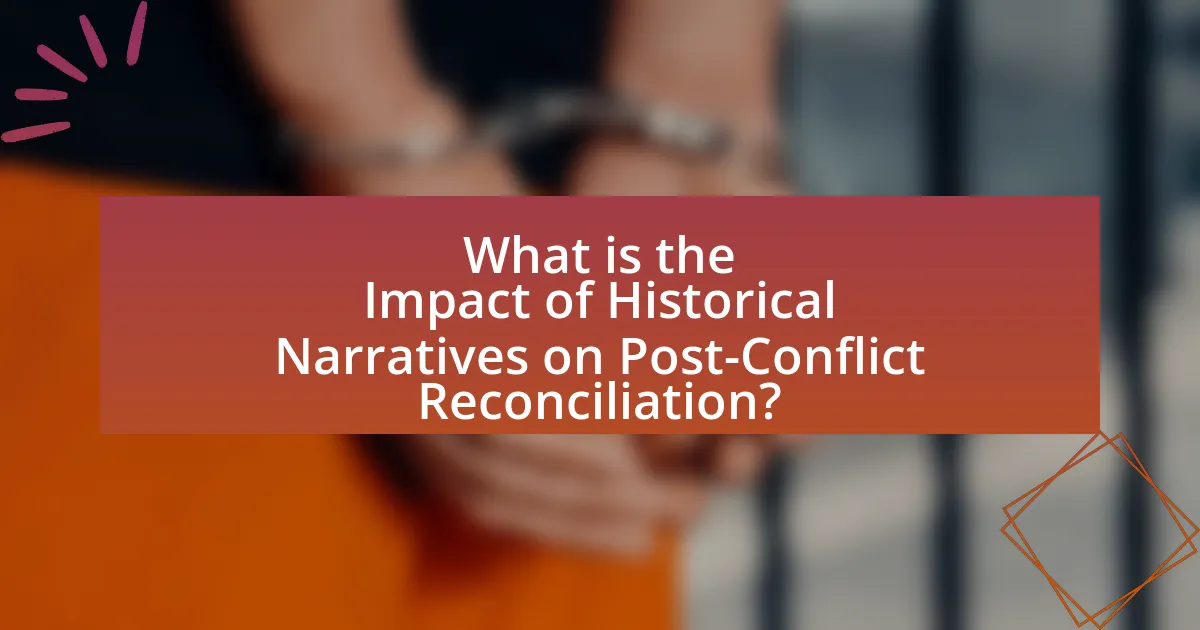
What is the Impact of Historical Narratives on Post-Conflict Reconciliation?
Historical narratives significantly influence post-conflict reconciliation by shaping collective memory and identity. These narratives can either foster understanding and empathy among conflicting parties or perpetuate division and resentment. For instance, in the aftermath of the Rwandan Genocide, the government promoted a narrative of unity and reconciliation, which was crucial in rebuilding the nation and facilitating healing among survivors and perpetrators. Conversely, in the Balkans, conflicting historical narratives have hindered reconciliation efforts, as groups cling to victimhood and blame, obstructing dialogue and mutual understanding. Thus, the impact of historical narratives is profound, as they can either facilitate or obstruct the reconciliation process, depending on how they are constructed and communicated.
How do historical narratives shape collective memory in post-conflict societies?
Historical narratives shape collective memory in post-conflict societies by influencing how communities remember and interpret their past experiences. These narratives often serve as frameworks through which individuals and groups understand their identities and relationships with others, particularly in the context of trauma and reconciliation. For instance, in Rwanda, the narrative surrounding the 1994 genocide has been pivotal in shaping collective memory, as it emphasizes themes of unity and forgiveness, which are essential for national healing. Research by scholars such as Paul Kagame highlights that the official narrative promoted by the Rwandan government has significantly impacted societal attitudes towards reconciliation and coexistence. Thus, the construction and dissemination of historical narratives play a crucial role in determining how collective memory is formed and utilized in post-conflict contexts.
What role does collective memory play in the reconciliation process?
Collective memory plays a crucial role in the reconciliation process by shaping the narratives that communities use to understand their past and envision their future. It influences how groups remember historical events, particularly conflicts, and can either facilitate healing or perpetuate division. For instance, in post-apartheid South Africa, the Truth and Reconciliation Commission utilized collective memory to address past injustices, allowing for a shared understanding of history that promoted national unity. This approach demonstrated that when collective memory is harnessed positively, it can foster empathy and dialogue, essential components for successful reconciliation.
How can differing historical narratives lead to conflict or division?
Differing historical narratives can lead to conflict or division by creating contrasting perceptions of identity, legitimacy, and victimhood among groups. When one group’s historical account is perceived as invalid or threatening by another, it can foster resentment and hostility, as seen in the Israeli-Palestinian conflict where both sides have deeply entrenched narratives about land and sovereignty. These conflicting narratives can perpetuate cycles of mistrust and violence, as groups may feel justified in their actions based on their interpretation of history. For instance, the Rwandan Genocide was fueled by differing historical interpretations of ethnic identities, leading to catastrophic consequences. Thus, the divergence in historical narratives not only shapes group identities but also influences political dynamics, often resulting in ongoing divisions and conflicts.
Why are historical narratives important in the context of reconciliation?
Historical narratives are crucial in the context of reconciliation because they shape collective memory and influence how communities understand past conflicts. These narratives provide a framework for acknowledging grievances, fostering empathy, and facilitating dialogue among affected groups. For instance, in post-apartheid South Africa, the Truth and Reconciliation Commission utilized historical narratives to address human rights violations, allowing victims and perpetrators to share their stories, which helped to build a shared understanding of the past. This process is essential for healing and moving forward, as it encourages recognition of diverse perspectives and promotes a sense of justice and closure.
What psychological effects do historical narratives have on individuals and communities?
Historical narratives significantly influence the psychological well-being of individuals and communities by shaping identity, fostering collective memory, and impacting social cohesion. These narratives can evoke emotions such as pride or shame, which in turn affect self-perception and group dynamics. For instance, research by Bar-Tal (2000) highlights that shared historical narratives can create a sense of belonging and solidarity among community members, while conflicting narratives may lead to division and mistrust. Furthermore, narratives that emphasize resilience and recovery can promote healing in post-conflict societies, as evidenced by studies showing that communities engaged in collective storytelling often experience improved mental health outcomes and enhanced social bonds.
How do historical narratives influence perceptions of justice and accountability?
Historical narratives significantly shape perceptions of justice and accountability by framing collective memory and influencing societal values. These narratives often highlight specific events, such as wars or genocides, and the responses to them, which can create a shared understanding of what constitutes justice. For instance, in post-apartheid South Africa, the Truth and Reconciliation Commission utilized historical narratives to address past injustices, fostering a collective acknowledgment of suffering and promoting accountability among perpetrators. This approach demonstrated that how history is told can either facilitate healing and reconciliation or perpetuate division and resentment, as seen in countries where historical grievances remain unaddressed. Thus, the way historical events are interpreted and communicated directly impacts societal expectations of justice and the mechanisms of accountability that follow.
What are the key components of effective historical narratives for reconciliation?
Effective historical narratives for reconciliation include truth-telling, acknowledgment of past injustices, inclusive perspectives, and a focus on shared humanity. Truth-telling ensures that accurate accounts of events are presented, which is essential for building trust among conflicting parties. Acknowledgment of past injustices allows victims to feel recognized and validated, fostering a sense of closure. Inclusive perspectives ensure that multiple viewpoints are represented, promoting understanding and empathy among different groups. Lastly, a focus on shared humanity emphasizes common values and experiences, which can help bridge divides and facilitate healing. These components are supported by various case studies, such as the Truth and Reconciliation Commission in South Africa, which highlighted the importance of these elements in fostering national healing and unity.
What elements make a historical narrative inclusive and representative?
An inclusive and representative historical narrative incorporates diverse perspectives, acknowledges marginalized voices, and emphasizes shared experiences. By integrating viewpoints from various cultural, social, and ethnic backgrounds, the narrative reflects the complexity of historical events. For instance, the Truth and Reconciliation Commission in South Africa highlighted the importance of including testimonies from victims of apartheid to create a comprehensive understanding of the past. This approach fosters empathy and promotes healing by recognizing the multifaceted nature of history, ultimately aiding in post-conflict reconciliation efforts.
How can historical narratives be constructed to promote healing and understanding?
Historical narratives can be constructed to promote healing and understanding by emphasizing shared experiences and acknowledging diverse perspectives. This approach fosters empathy among conflicting groups, as seen in post-apartheid South Africa, where the Truth and Reconciliation Commission highlighted personal stories from both victims and perpetrators, facilitating dialogue and mutual recognition of suffering. By integrating multiple viewpoints, historical narratives can create a more inclusive understanding of the past, which is essential for rebuilding trust and fostering social cohesion in post-conflict societies.
How do historical narratives interact with political processes in post-conflict settings?
Historical narratives significantly shape political processes in post-conflict settings by influencing collective memory and identity formation. These narratives often serve as tools for political leaders to legitimize their authority, mobilize support, or justify policies, as seen in countries like Rwanda, where the narrative of genocide has been utilized to foster national unity and reconciliation efforts. Furthermore, historical narratives can either facilitate or hinder peacebuilding, depending on whether they promote inclusive or exclusive interpretations of the past. For instance, in Bosnia, competing narratives about the war have perpetuated divisions and obstructed political cooperation, demonstrating how divergent historical accounts can impact governance and social cohesion.
What challenges arise in reconciling conflicting historical narratives?
Reconciling conflicting historical narratives presents significant challenges, primarily due to differing interpretations of events, cultural biases, and the emotional weight of collective memory. These challenges arise because each narrative often reflects the values and experiences of specific groups, leading to entrenched positions that resist compromise. For instance, in post-conflict societies, such as in Rwanda after the genocide, the narratives of the Hutu and Tutsi communities diverged sharply, complicating efforts for national unity and reconciliation. The emotional attachment to these narratives can hinder dialogue, as individuals may perceive opposing views as threats to their identity or historical legitimacy. Furthermore, the lack of a shared framework for understanding history can result in ongoing tensions and conflict, making it difficult to establish a common ground necessary for reconciliation.
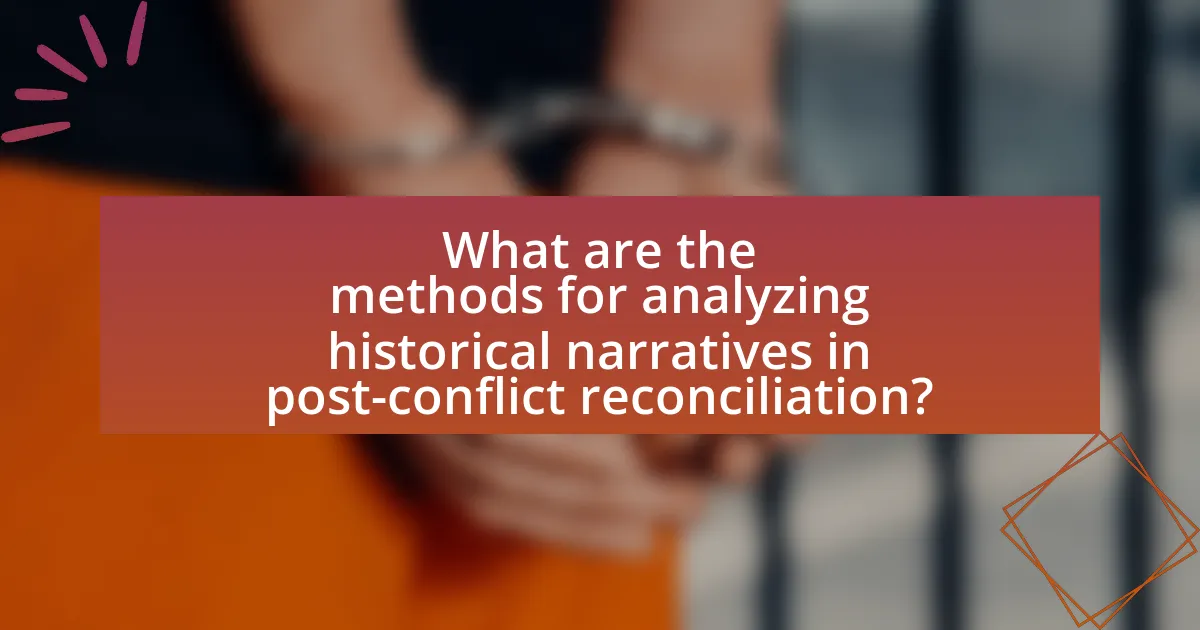
What are the methods for analyzing historical narratives in post-conflict reconciliation?
Methods for analyzing historical narratives in post-conflict reconciliation include qualitative content analysis, discourse analysis, and narrative analysis. Qualitative content analysis systematically examines texts to identify themes and patterns that reveal how historical events are interpreted by different groups. Discourse analysis focuses on the language used in narratives, exploring how power dynamics and social contexts shape the portrayal of history. Narrative analysis investigates the structure and function of stories told by individuals or communities, highlighting how these narratives contribute to identity formation and collective memory. These methods are validated by studies such as “The Role of Historical Narratives in Post-Conflict Reconciliation” by John Paul Lederach, which emphasizes the importance of understanding diverse perspectives in fostering dialogue and healing.
How can qualitative research methods be applied to study historical narratives?
Qualitative research methods can be applied to study historical narratives by utilizing techniques such as interviews, focus groups, and content analysis to gather in-depth insights into personal and collective memories. These methods allow researchers to explore how individuals and communities interpret and construct their historical experiences, particularly in the context of post-conflict reconciliation. For instance, interviews with survivors of a conflict can reveal how their narratives shape their identities and influence their perceptions of the past, which is crucial for understanding the broader societal implications of historical narratives in reconciliation processes. Additionally, content analysis of historical texts and media can uncover prevailing themes and biases that affect collective memory, thereby providing a comprehensive view of how historical narratives are formed and contested.
What tools and frameworks are useful for analyzing narratives?
Tools and frameworks useful for analyzing narratives include narrative analysis, discourse analysis, and thematic analysis. Narrative analysis focuses on the structure and content of stories to understand how they shape identity and meaning, particularly in post-conflict contexts. Discourse analysis examines language use and power dynamics within narratives, revealing how narratives influence social perceptions and relationships. Thematic analysis identifies recurring themes within narratives, allowing researchers to explore commonalities and divergences in experiences and interpretations. These methodologies are supported by various studies, such as those by Riessman (2008) on narrative analysis and Gee (2014) on discourse analysis, which demonstrate their effectiveness in unpacking complex narratives in social and historical contexts.
How do researchers ensure objectivity when analyzing historical narratives?
Researchers ensure objectivity when analyzing historical narratives by employing rigorous methodologies, including triangulation, peer review, and critical analysis of sources. Triangulation involves cross-referencing multiple sources to validate information, which helps mitigate bias. Peer review allows other experts to evaluate the research for potential biases or inaccuracies, ensuring a more balanced perspective. Additionally, researchers critically analyze the context, authorship, and purpose of historical narratives, which aids in identifying subjective elements. For instance, studies have shown that narratives shaped by political agendas often differ significantly from those based on empirical evidence, highlighting the importance of source evaluation in maintaining objectivity.
What role do education and media play in shaping historical narratives?
Education and media play a crucial role in shaping historical narratives by influencing public perception and understanding of past events. Educational institutions provide frameworks for interpreting history, often emphasizing specific perspectives that can either promote unity or deepen divisions within societies. For instance, curricula that highlight certain events while omitting others can create biased narratives that affect collective memory. Media, on the other hand, disseminates information and interpretations of historical events to a broader audience, shaping public discourse. Research shows that media representation can reinforce or challenge existing narratives, as seen in post-conflict societies where media coverage of historical grievances can either exacerbate tensions or foster reconciliation. For example, in Rwanda, media played a significant role in both the incitement of violence during the genocide and the promotion of peace and unity in its aftermath. Thus, both education and media are instrumental in constructing and reconstructing historical narratives that impact societal healing and reconciliation processes.
How can educational curricula be designed to foster reconciliation through historical narratives?
Educational curricula can be designed to foster reconciliation through historical narratives by integrating diverse perspectives that reflect the experiences of all groups involved in a conflict. This approach encourages critical thinking and empathy among students, allowing them to understand the complexities of historical events. For instance, including narratives from marginalized communities can highlight injustices and promote dialogue about past grievances, which is essential for healing. Research indicates that curricula emphasizing multiple viewpoints can reduce prejudice and foster social cohesion, as seen in post-apartheid South Africa, where educational reforms aimed at inclusivity have contributed to national reconciliation efforts.
What impact does media representation have on public understanding of historical narratives?
Media representation significantly shapes public understanding of historical narratives by influencing perceptions and interpretations of past events. For instance, documentaries, films, and news coverage can highlight specific aspects of history while omitting others, thereby framing narratives in a way that aligns with particular viewpoints. Research indicates that media portrayal can reinforce stereotypes or challenge dominant narratives, affecting collective memory and identity. A study by the Pew Research Center found that individuals exposed to diverse media representations of historical events are more likely to develop a nuanced understanding of those events, illustrating the media’s role in shaping public discourse and reconciliation processes in post-conflict societies.
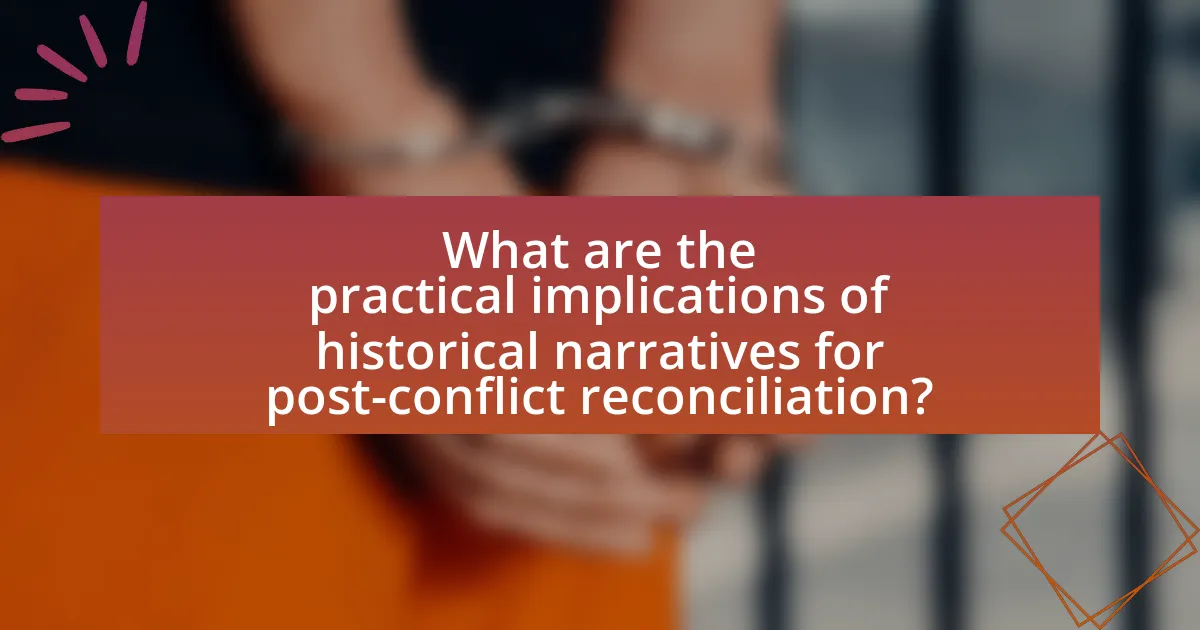
What are the practical implications of historical narratives for post-conflict reconciliation?
Historical narratives play a crucial role in post-conflict reconciliation by shaping collective memory and influencing societal attitudes toward former adversaries. These narratives can either promote understanding and empathy or perpetuate division and resentment, depending on how they are constructed and disseminated. For instance, inclusive historical narratives that acknowledge multiple perspectives can foster dialogue and healing, as seen in South Africa’s Truth and Reconciliation Commission, which aimed to address past injustices and promote national unity. Conversely, exclusive narratives that glorify one group’s suffering while demonizing others can hinder reconciliation efforts, as evidenced in the former Yugoslavia, where competing historical accounts have fueled ongoing tensions. Thus, the practical implications of historical narratives are significant, as they can either facilitate or obstruct the reconciliation process in post-conflict societies.
How can communities effectively utilize historical narratives for reconciliation efforts?
Communities can effectively utilize historical narratives for reconciliation efforts by fostering dialogue that acknowledges past injustices and promotes understanding among diverse groups. This approach allows communities to confront historical grievances, as seen in South Africa’s Truth and Reconciliation Commission, which used narratives to address apartheid’s legacy and facilitate healing. By sharing personal stories and collective memories, communities can build empathy and create a shared identity, which is crucial for moving forward. Research indicates that engaging with historical narratives can reduce prejudice and enhance social cohesion, as demonstrated in studies on post-conflict societies where narrative-sharing initiatives have led to improved intergroup relations.
What best practices can be adopted for integrating historical narratives into peacebuilding initiatives?
Integrating historical narratives into peacebuilding initiatives can be effectively achieved through several best practices. First, involving local communities in the narrative development process ensures that the stories reflect diverse perspectives and experiences, fostering ownership and relevance. For example, the Truth and Reconciliation Commission in South Africa successfully utilized personal testimonies to create a collective narrative that acknowledged past injustices, which helped in healing and reconciliation.
Second, utilizing educational programs that incorporate historical narratives can promote understanding and empathy among conflicting groups. Research indicates that educational interventions that include historical context can reduce prejudice and foster dialogue, as seen in the case of the “History and Memory” project in Bosnia and Herzegovina, which aimed to bridge divides through shared historical understanding.
Third, employing multimedia platforms to disseminate historical narratives can reach broader audiences and engage younger generations. The use of documentaries and social media campaigns has proven effective in various peacebuilding contexts, such as the “Stories of Peace” initiative in Colombia, which highlighted personal stories of reconciliation and resilience.
Lastly, continuous evaluation and adaptation of these narratives based on community feedback can enhance their impact. Engaging in regular dialogue with stakeholders allows for the narratives to evolve and remain relevant, as demonstrated by the ongoing efforts in Rwanda to address historical narratives surrounding the genocide, which adapt to the changing social landscape.
These best practices collectively contribute to a more inclusive and effective integration of historical narratives into peacebuilding initiatives, ultimately supporting post-conflict reconciliation efforts.
How can storytelling be leveraged to enhance reconciliation processes?
Storytelling can be leveraged to enhance reconciliation processes by facilitating empathy and understanding among conflicting parties. Through narratives, individuals can share personal experiences and perspectives, which humanizes the ‘other’ and fosters emotional connections. For instance, in post-apartheid South Africa, the Truth and Reconciliation Commission utilized storytelling to allow victims and perpetrators to recount their experiences, promoting healing and acknowledgment of past injustices. This approach has been shown to reduce animosity and build trust, as evidenced by studies indicating that shared narratives can lead to improved intergroup relations and a greater willingness to engage in dialogue.
What lessons can be learned from case studies of historical narratives in reconciliation?
Case studies of historical narratives in reconciliation reveal that acknowledging diverse perspectives fosters understanding and empathy among conflicting groups. For instance, the Truth and Reconciliation Commission in South Africa highlighted the importance of sharing personal stories to humanize experiences and promote healing. Additionally, the case of Rwanda post-genocide demonstrates that integrating multiple narratives into educational curricula can help rebuild trust and prevent future conflicts. These examples underscore that inclusive historical narratives are essential for creating a shared sense of identity and facilitating long-term reconciliation.
What successful examples exist of historical narratives facilitating reconciliation?
Successful examples of historical narratives facilitating reconciliation include South Africa’s Truth and Reconciliation Commission (TRC) and the post-war reconciliation efforts in Rwanda. The TRC, established in 1995, aimed to address the atrocities committed during apartheid by documenting human rights violations and promoting national healing through public testimonies. This process allowed victims and perpetrators to share their stories, fostering understanding and forgiveness, which contributed to a more unified society. In Rwanda, the Gacaca courts, initiated in 2002, utilized community-based justice to address the 1994 genocide. These courts encouraged open dialogue about the past, enabling communities to confront their history collectively, which played a crucial role in rebuilding trust and social cohesion. Both examples illustrate how structured historical narratives can facilitate reconciliation by promoting dialogue, understanding, and healing in post-conflict societies.
What common pitfalls should be avoided in the use of historical narratives for reconciliation?
Common pitfalls to avoid in the use of historical narratives for reconciliation include oversimplification of complex events, selective memory, and the promotion of a singular narrative that marginalizes other perspectives. Oversimplification can lead to a distorted understanding of the past, as seen in many post-conflict societies where nuanced histories are reduced to binary good versus evil narratives. Selective memory often results in the omission of significant events or experiences that are crucial for a comprehensive understanding of the conflict, which can alienate affected groups. Additionally, promoting a singular narrative can reinforce divisions rather than foster unity, as it may invalidate the experiences and histories of other communities involved. These pitfalls can hinder genuine reconciliation efforts by perpetuating grievances and preventing a shared understanding of the past.
How can individuals contribute to the reconciliation process through historical narratives?
Individuals can contribute to the reconciliation process through historical narratives by sharing personal stories that highlight diverse perspectives and experiences related to past conflicts. These narratives foster understanding and empathy among different groups, which is essential for healing and rebuilding trust. For instance, in post-apartheid South Africa, the Truth and Reconciliation Commission encouraged individuals to recount their experiences, allowing for a collective acknowledgment of injustices and fostering dialogue. This process not only validates the experiences of marginalized voices but also creates a shared historical understanding that is crucial for moving forward together.

